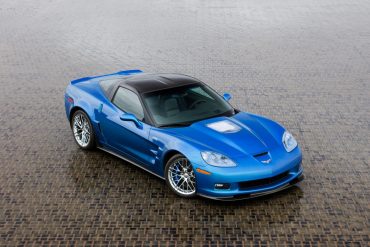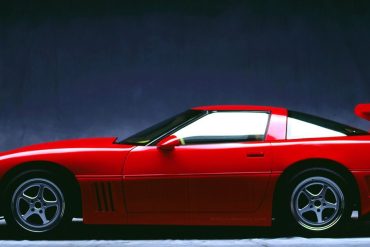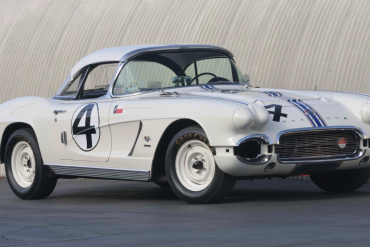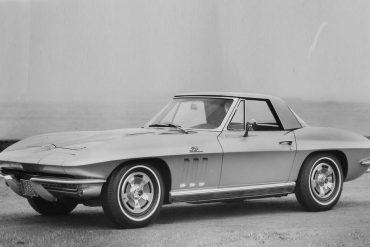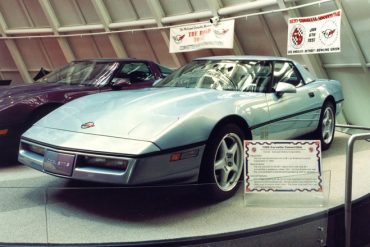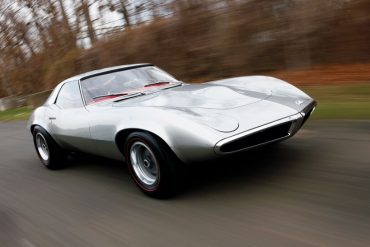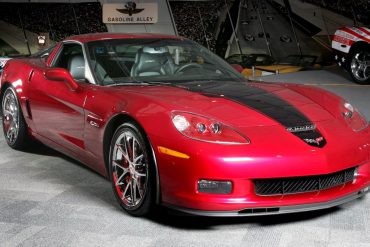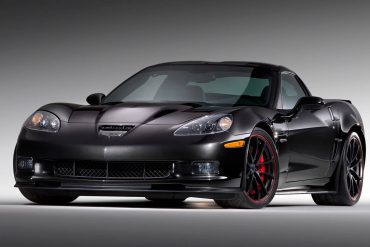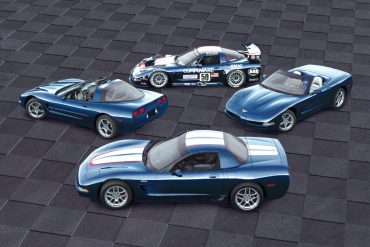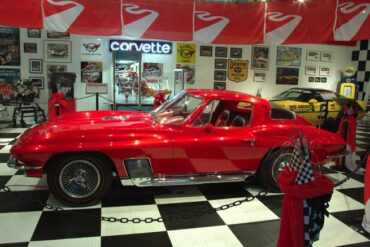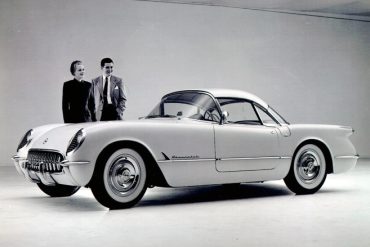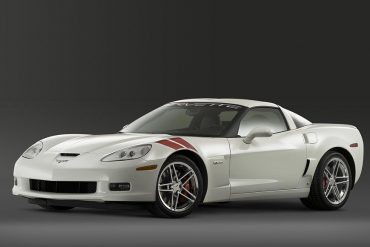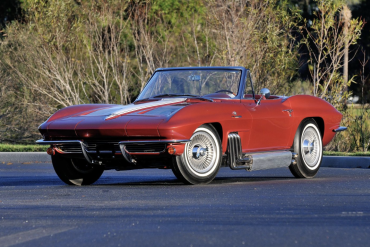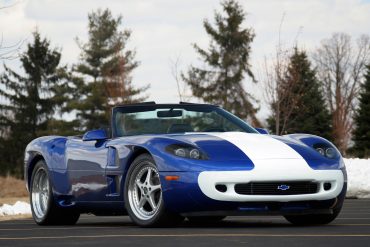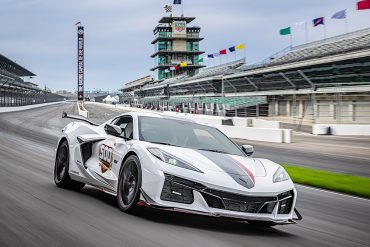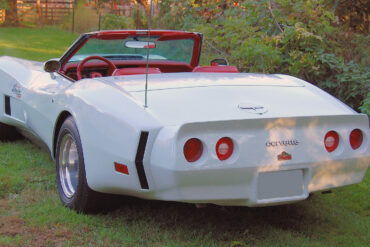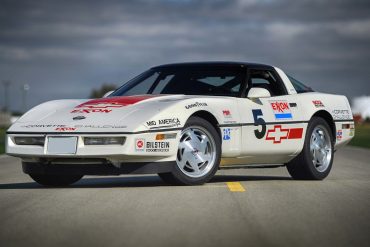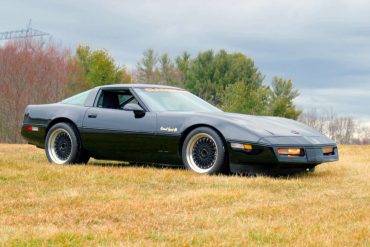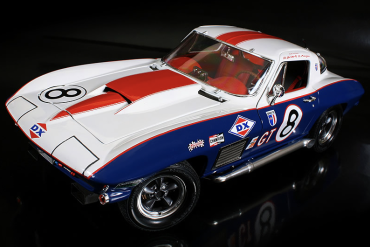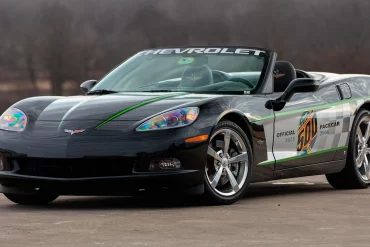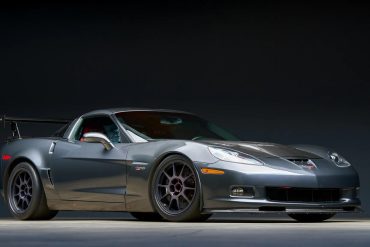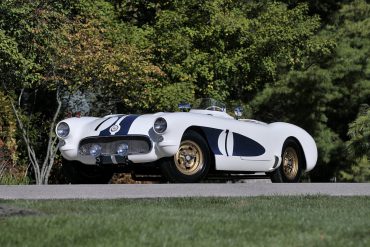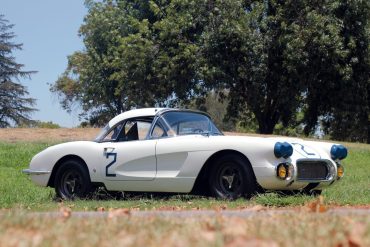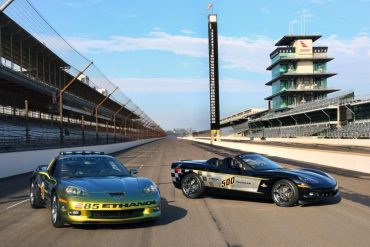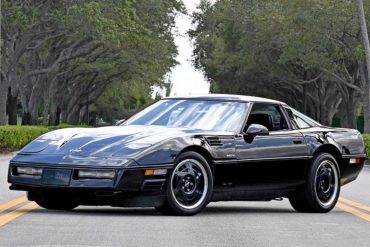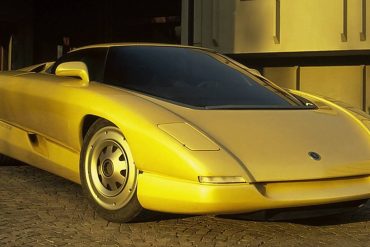The ZR-1 returned with the 1990 Corvette lineup after an eighteen year hiatus. This time, it featured a special LT5 engine that had been developed by Lotus (which, at the time, had been a subsidiary of General Motors.) The LT5 engine featured an all-aluminum block, four overhead camshafts, and 32 valves. It also featured an air management system which enabled the car to maintain proper operation while closing off half of its fuel injection system.
Reeves Callaway has always had a dream of competing a Corvette of his own at the 24 Hours of Le Mans, France. The idea begin with the body work for a street version, but one thing led to another, and a full race version was completed as well. The street version is almost identical to the race version because the hood, tail, rocker panels, and lower door halves, are all made of carbon fiber, just like the race version.
Always on the hunt for greater speed and greater thrills, Delmo decided to replace the '61 he had been racing with a brand-new 1962 Chevy Corvette. Owing to his demonstrated skill behind the wheel and prior successes with Corvettes, Delmo had a close relationship with legendary chief engineer Zora Arkus-Duntov and enlisted his assistance with the new car. "It was easy," Delmo recalls. "I called Zora and said, 'Build me a race car.' The only other thing I said was to make it white."
For competition, race customers had a range of options available to them including the N03 36-Gallon Fuel Tank, closer rear axle ratios and the C48 Heater/Defroster Delete (-100). Most cars equipped like this came with either L78 or the L84 with Ram-Jet Fuel Injection.
There were several successful attempts to build a convertible ZR-1, most of them by private people. The DR-1 was a GM prototype to test the structural integrity of the ZR-1 chassis when it would be topless. The car was built by American Sunroof Corporation (ASC) for Don Runkle, who was the vice-president of Advanced Engineering Staff, which explains the “DR-1” designation. It was a standard convertible transformed to ZR-1 specs.
When first introduced to the world by Pontiac in 1964, the car showed so much promise that Chevrolet (allegedly) put a swift end to its development to prevent its production from hindering the sales of the Corvette. Afterall, with the introduction of the 1963 Split-Window Corvette, Chevy was finally seeing an increase in sales, something lacking for most of the first-gen.
The 427 Limited Edition option, code Q8A and Z44, was limited to 505 examples globally with 427 destined for North American customers. As a retirement gift to Wil Cooksey, the Corvette plant manager from 1993 to 2008, he chose the color scheme and hand signed and numbered the underside of the armrest console lids on all 505 examples in which this example is #6. As part of the package, the seats and the floor mats have “427” embroidery, and the center-console trim plate is color matched.
The Centennial Edition came finished exclusively in a Carbon Flash Metallic finish with satin-black graphics. Special badging graphics signifying Chevrolet’s racing history, including an image of Louis Chevrolet on the B-pillars, were added as accents to the cars finish. The wheels were also finished in satin black. All models also received red brake calipers. The exterior color scheme of the Centennial Edition Corvette is reinforced inside the car.
The Cheetah was meant to be a Cobra-killer. It was Corvette powered, with a custom-designed chassis and suspension. There has...
It was only fitting that the Corvette design team honor the outgoing C5 by saluting its finest racing accomplishments with a special Le Mans Commemorative Edition package for all 2004 Corvette models. The Coupe and Convertible packages included special Le Mans Blue metallic paint, unique badging noting the Le Mans victories, polished wheels, and a special shale-colored interior featuring embroidered Le Mans emblems on the headrests.
For the 1964 New York World's Fair, Bill Mitchell and his Styling team at the Tech Center customized a production Sting Ray under Shop Order #10361 with a variety of items that transformed the already impressive Corvette into a showpiece like no other. An opening was cut into the center of the car's hood exposing a polished fuel injection manifold with the Corvette crossed flags in its very center.
Besides a normal convertible model, the 1954 Chevrolet Corvette line-up also featured a hardtop, actually a Convertible Coupe. It was one of the Corvette based Motorama dream cars shown in 1954 and was a version fitted with a removable hardtop. The Advertising Brochure even called out the removable hardtop design.
The Corvette C6.R was introduced to the world in 2005, as both the motorsports testbed of the forthcoming C6 Z06 and C6 ZR1, and as...
The Ron Fellows ALMS GT1 Champion Edition Corvette was introduced as part of the 2007 Corvette line-up. To commemorate Mr. Fellows long and successful career with the Corvette Racing program, Chevrolet introduced the Ron Fellows Championship Edition Z06 Corvette as part of their 2007 model line-up. It was released as a commemorative model to celebrate one of GM's winning-est drivers, but did little to impress enthusiasts or collectors when first introduced.
The Corvette built for 'Bunkie' Knudsen is a 1963 Chevrolet Corvette styling car known as the "Bunkie" Knudsen Corvette, built for Chevrolet general manager Semon E. "Bunkie" Knudsen. Finished in Rose Pearl with a full-length White racing stripe, it is outwardly distinguished by its chromed header-style pipes.
To understand why the Guldstrand GS-90 coupe and convertible differ so much, keep in mind that during the course of the C4 development cycle, no ZR-1 convertibles were planned, so the base C4 convertible had to be used in building a GS-90 Nassau Roadster, as it was called. The coupe, however, had the advantage of using the ZR-1 platform right from the get-go.
The 2023 Corvette Z06 pace car uses the same 670-horsepower 5.5-liter naturally aspirated V8 as the road-going version. It has the Z07 Performance Package that has additional features like Magnetic Ride Control 4.0 calibrations, carbon-fiber wheels with Michelin Sport Cup 2 R ZP tires, and carbon-ceramic brakes. The pack also adds carbon pieces to the body.
The Duntov Turbo was built as a partnership between American Custom Industries (ACI), a company known for building replacement Corvette body panels, and Zora Arkus-Duntov. It was developed as a highly-stylized convertible sports car based on the production model Corvette. Each of the special Duntov Turbo's also came with a turbocharged V8.
Chevrolet knows their clientele, and with the 1996 Corvette Collector's Edition LT4, the automaker put together a special package that would entice hard-core 'Vette fans with a unique tribute to the outgoing C4 model. The $1250 option brought unique Sebring Silver Metallic paint, 5-spoke wheels, and, of course, special badges and embroidery. It also received the upgraded LT4 powerplant available in the Grand Sport, and with 330 horsepower on tap.
The 1988 Corvette Challenge Series was created by John Powell of Powell Motorsports. Chevrolet built fifty-six identical Corvettes for the first year of the Corvette Challenge in 1988. Each was equipped exactly the same, with all standard equipment, the 245hp Cross-Fire fuel injection engine, Doug Nash 4+3 transmission, Z51 Handling Suspension package.
When Dick Guldstrand introduced the GS80 series in 1986, the car was targeted specifically at Pro-Solo and autocross enthusiasts. He knew all about the needs of these groups, as he was a longtime provider of performance upgrades for the C3 and a direct supporter of a small team of racers from the Western Council of Corvette Clubs. Up to this point, Dick had basically been a tuner. With the intro of the GS80 he was venturing into the realm of small-volume manufacturing.
At Sebring in 1967, the Corvette L88 made its debut appearance. The L88 package included many competition components which included a M22 transmission, large disc brakes, upgraded suspension and an alumunim head 427. Shortly after the race, the L88 option would be offered on production cars which was a formidable package.
Total Production for the 2008 Indy Pace Car replicas sold to the public was 500. The first replica rolled off the production line approximately March 4th, and the last was June 6th. There were 61 Corvettes built in early March, however only 60 cars shipped to the Indianapolis Motor Speedway to be used as rack” and “festival committee" vehicles which were distributed to their lucky drivers on April 9th and in use thru May 31st.
This 2009 Chevrolet Corvette Z06 has been extensively modified for track use. It features a 7.0-liter LS7 V8 crate engine...
In 1956, Ed Cole, then General Manager of Chevrolet, decided Corvette could be saved from extinction due to lagging sales by promoting the car as a performance car which could be raced in production classes. The first of these Corvettes was to debut at Daytona Beach for acceleration and top end speed trials, the 12 hour race at Sebring, and also possibly Le Mans.
The story of the Corvette and how it came to race at Le Mans is one in which the dreams of a number of individuals intersect, over a prolonged period of time. While each of these dreamers came from vastly different backgrounds and held often times very different agendas, they all shared a common vision—an American sports car winning the 24 Hours of Le Mans. For Le Mans, the Sebring #2 car was renumbered as #1.
Known for their charismatic designs and superior performance, the pack-leading Pace Cars share a special place in Indianapolis 500 lore. History was made at the 2008 Indianapolis 500 when a pair of distinctive yet highly differentiated Corvette models served as the Official Pace Cars — one highlighting a commitment to fuel solutions and the other marking 30 years of Corvette's Pace Car heritage.
This vehicle pioneered the advantages of “Active Suspension” and had GTP Corvette race car technology. Built at the Bowling Green Plant, this vehicle was developed as a prototype for a limited edition run in the 1990 model year. Chevrolet ordered it to be built with a complex, high-tech active suspension that includes an Eaton hydraulic pump and Moog actuators. This car and the technology inside of it led to the Active Handling system GM released in 1996.
Chevrolet introduced the limited production Corvette GT1 Championship Edition at Sebring International Raceway. The GT1 Championship Edition (Regular Production Option GT1) commemorates the success of Corvette Racing and the Corvette C6R.
The Nivola may be considered Bertone’s homage to the most fascinating American sports car: the Chevrolet Corvette. The sophisticated mechanical unit of the ZR-1 was interpreted by Bertone in a European key. Bertone designed a special chassis to make a sporty "boat" with a mid engine. This mechanical layout made it possible to exploit all the power of the engine when accelerating and warrant perfect roadholding on bends.


